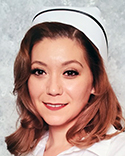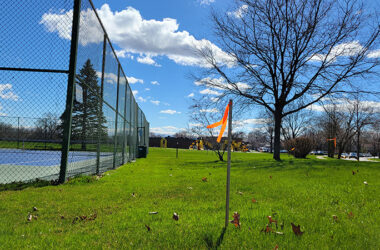This May, Prairie State College’s Nursing Program awarded the associate’s degree in nursing to 57 students. It is one of PSC’s largest graduating classes. Graduates started toward their RN degrees months before the COVID-19 virus hit the United States. There is a fear of the unknown, and yet they say the highly contagious infection isn’t scaring them off from the profession. They are ready to join the ranks of medical staff working in hospitals in the area.
This May, Prairie State College’s Nursing Program awarded the associate’s degree in nursing to 57 students. It is one of PSC’s largest graduating classes.
The coronavirus pandemic did force students to finish their last semester through remote learning, not the best way to get hands-on experience. It also meant they didn’t get their RN pinning ceremony May 14, or their graduation ceremony May 16.
These graduates started toward their RN degrees months before the COVID-19 virus hit the United States. There is a fear of the unknown, and yet they say the highly contagious infection isn’t scaring them off from the profession. They are ready to join the ranks of medical staff working in hospitals in the area.
Mom goes back to school
“I had always wanted to be a nurse,” said Marie Blasgen of Homewood. Her dream was interrupted when she and her husband, John, married and had two children.
“I’m a helper. I ‘ve always been interested in the medical profession,” she said. Blasgen finally decided to enroll in the nursing program five years ago when she went back to take the prerequisite courses. During that time, she had another baby.
“For me, the whole first semester, not coming with a medical background, it was eye-opening. Nursing school is very difficult,” she said. “I’ll never forget my last six weeks of nursing school. Me and three kids all doing e-learning at the same time!
“We finished strong, my friends and I. I think it’s a testament to how well you’re going to do as a nurse. We were able to adapt to the all-virtual environment.”
The 12-hour hospital shifts should make it easier for Blasgen to adjust her schedule to family life.
Clinical rotations gave her a look at what the medical profession has to offer. She was in a labor/delivery rotation when she witnessed a C-section.
“You’re scared and then adrenaline takes over and you’re interested in seeing what the doctor’s doing, the nurses, the anesthesiologist. In the end, it was such an amazing thing to see,” she recalled.
From LPN to RN
Candice Rodriguez has been working as a licensed practical nurse (LPN) for 10 years. She decided to earn a registered nurse (RN) degree because it offered her greater career flexibility, in addition to more pay.
Although the LPN status would have allowed her to skip a semester at PSC, Rodriguez said she enrolled for the full two-year program to get up-to-date with her skills, review ethical concerns and sensitive ways to deal with patients.
It also is recommended that RN students not work during the program, but Rodriguez is a single mother with two children, so she continued working, although she reduced her hours.
Rodriguez was a young mother with a sick child. Her baby was hospitalized three times before hitting the six-week mark. She said the attention of the staff “showed me a side of the medical profession that I really accepted. Not only did they treat my child, but they were really compassionate and caring for me as well.”
Seeing and experiencing that convinced her to go into the medical profession. Her first degree was for a medical lab assistant, then she got an LPN degree. She’s worked at school nursing, home health nursing, assisted living and Alzheimer’s care before going to nursing school.
She has been working as an LPN at St. Catherine’s Hospital in East Chicago, Indiana. Because Indiana has fewer restrictions on LPNs than Illinois, Rodriguez is working as an LPN medical/surgical oncology nurse.
There is a general fear of COVID-19 in the hospital, she said. For her the issue is not where is she working, but will she have the personal protective equipment “to keep myself safe so I can take care of my patients” and protect against bringing the virus home to her family.
Following mom into nursing
Tara Troli graduated from Prairie State’s nursing program, just like her mom, Christine, did in 1990.
“She’s been a big motivator for me,” Tara said. Her sister, Taylor, is a year behind her in the PSC nursing program.
After graduating from Homewood-Flossmoor High School, Troli went off to college thinking she’d be in a pre-med program. It just wasn’t working for her. She went to two colleges before returning to Chicago Heights and enrolling in the nursing program.
Now she feels prepared for anything, including a pandemic. Is she afraid? “Not really,” Troli said, “because there are sick people in the hospital regardless of COVID-19, and they have contagious diseases.” She recognizes that extra precautions are necessary for some patients.
“I honestly think Prairie State is a great place to go to school. The teachers I had at Prairie State seemed to care more about their students, and care about you passing,” Troli said.
For the 23-year-old, having to finish with remote learning wasn’t difficult. She’d taken online courses before. But the disruption to her routine “not seeing my classmates and teachers, you lose a little bit of motivation, at least for me.”
She will soon be applying to hospitals and will pursue a bachelor’s degree in nursing.
Teaching nursing skills
Director of Nursing Patti Eberhardt has been teaching at PSC since December 1996 “and I’ve seen a lot of changes, and I do think that we are getting a younger student. At one point the average age was 36. The majority have families or are single parents. They work hard and give up a lot to go into nursing,” she said.
The nursing program admits 88 students each year. Some drop out, but Eberhardt said more students are succeeding. The class of 2021 is the largest with a current enrollment of 66 students. She said PSC has developed a process to help with student retention.
“In the midst of COVID they’re all still out there wanting to become a nurse,” Eberhardt said. There was no way for faculty to teach to a pandemic, but the professor said, “from day 1 they are taught universal precautions. You always need to be prepared because in this situation you might know someone with COVID, but it’s the ones you don’t know that could have COVID.
“It’s the same with anything. You don’t know who’s walking around with a communicable disease, so you always have to practice universal precautions: wear gloves when you come into contact with bodily secretions, wash your hands,” she said. “I don’t think anyone could prepare for this. I’ve become friends with the graduates on Facebook and a lot of them are out there on the front lines now. It’s so unpredictable. They’re the ones who say ‘Stay home’ because they see the sick people in the hospitals.”
Blasgen, Rodriguez and Troli all intend to earn a bachelor’s degree in nursing (BSN). That’s typical. Eberhardt said graduate surveys report more than 90 percent of the graduates earn BSNs within five years.
“I really think that our students are the most caring and so grateful for their experiences at Prairie State College. You’re always seeing ‘PSC Proud’ and ‘Glad to be a graduate of Prairie State’ (on websites). They’re very loyal to Prairie State College and very invested in their nursing careers,” she said.



